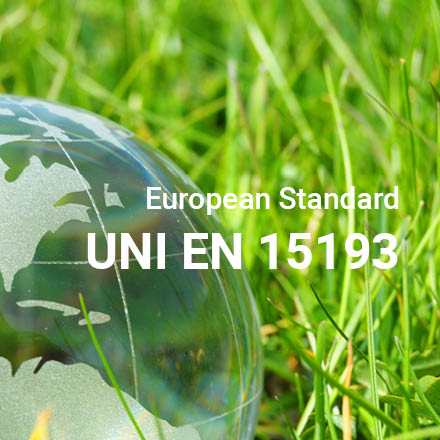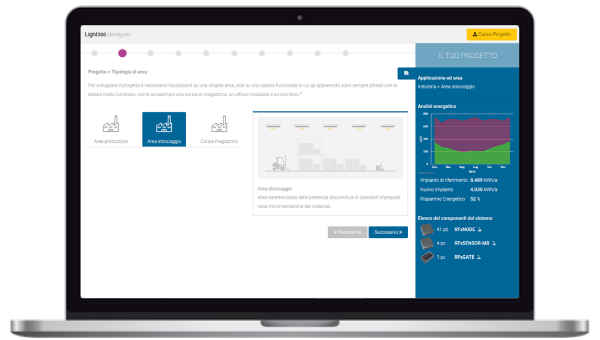Standard EN 15193-1 “Energy performance of buildings – Energy requirements for lighting” specifies the methodology for the evaluation of energy performance of lighting systems for general lighting in residential and non-residential buildings and for calculation or measurement of the amount of energy required or used for lighting in buildings.
The Standard considers both the characteristics of the luminaires and those of the automation systems that may be present. The method can be applied to new, existing or revamped buildings and consists of multiple calculation methods, with different precision levels (detailed, simplified or by direct measurement).
The detailed method allows you to evaluate exhaustively the impact of all the components that can determine energy consumption and is particularly useful for estimating the effectiveness of the control and automation devices present and/or planned on the system.
For each building category, classified according to its purpose, various types of rooms that compose it and the value of the parameters useful for the calculation are defined. The indicator in question is the LENI (Lighting Energy Numeric Indicator) and expresses the energy consumed in a building for lighting referring to one m2 in a year.
LENI = (Pn/Area)* Fc * (Fd*Fo*Td + Fo*Tn) + 1,0 + 1,5 [kWh/m2 year]
The variables that determine LENI value in turn depend on several factors:
Pn Indicates the nominal power of the lighting system
Fc Depends on the oversizing of the system power
Fo Depends on the occupation degree of the illuminated area
Fd Depends on how the control system uses natural light
Td Indicates the number of hours per year in which the system works in the presence of natural light
Tn Indicates the number of hours per year in which the system works in the absence of natural light
Area indicates the surface of the illuminated area.
When the area is discontinuosly occupied and there is a control system able to automatically manage the presence, Fo values obtained are as much better as they are less than 1. This parameter determines the time in which the luminaires remain switched off, with a consequent reduction in consumption and an increase in the lifetime of the lighting fixtures, which therefore also leads to savings in maintenance and relamping costs.
If the lighting system is equipped with adjustable (dimmable) luminaires and the control system allows automatic management of the brightness in relation to the contribution of natural light, the Fd parameter is less than 1. The reduction in consumption due to the ability to exploit natural light depends obviously on the location of the building (latitude) and its construction features, such as the geometric indeces of the windows. The lighting control also allows you to limit the power of the system coming from the initial oversizing (maintenance factor), allowing energy savings even in the absence of natural light.
LENI calculation software
The calculation of the LENI depends on several factors obtained with the considerations and methodologies developed in details in the reference standard EN15193-1. The practical application of this calculation method is not so immediate and for this reason the LENICAL software has been developed by ENEA, which simplifies its evaluation.
The LENICAL software calculates the LENI indicator, according to the complete EN 15193-1: 2017 method and guides the user in the correct determination of each parameter required for the calculation, strictly respecting the standard.
LENICALC is accompanied by some simple explanations contained in the Reference Practice UNI / PdR 77: 2020 “Guidelines for computerized calculation for LENI determination according to the complete calculation method of UNI EN 15193-1: 2017” which guides the user during the calculation process (available on the UNI website at link http://store.uni.com/catalogo/uni-pdr-77-2020).
LENICALC software is available for free on PELL (Public Energy Lighting Lab) web page of ENEA at the link https://www.pell.enea.it/lenicalc.
LENI evaluation is fundamental to determine the effectiveness of a lighting control system in order to calculate the energy saving it introduces, compared to a non-automated solution. For this reason ZETAQLAB has developed a simplified and free calculation tool on the portal www.light360.cloud. Thanks to this web-based software it is possible to estimate LENI, and therefore the related consumption of the system, allowing an energy evaluation for commercial purposes, which is approximated compared to the detailed technical analysis obtained through LENICALC.
Two tools for LENI estimation are available on the www.light360.cloud portal.
Light360|Energy
This tool allows the simple determination of LENI and of the energy consumption of a system, considering its general features and conditions of use. The results can be exported to a customized pdf file.
Further information >>
Light360|Designer
Besides LENI evaluation, this tool guides the user to project the best control system to optimize energy saving. Furthermore, the automation and control system is evaluated according to the EN15232 Standard, in order to verify its correct compatibility with the current legal standards. The results can be exported to a customized pdf file.
Further information >>

